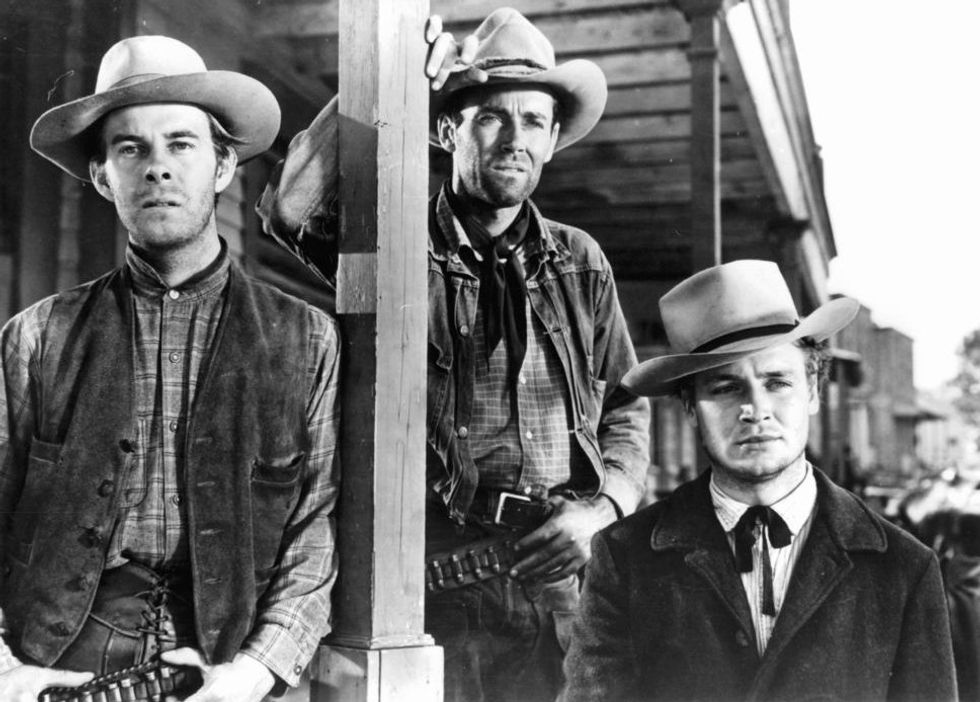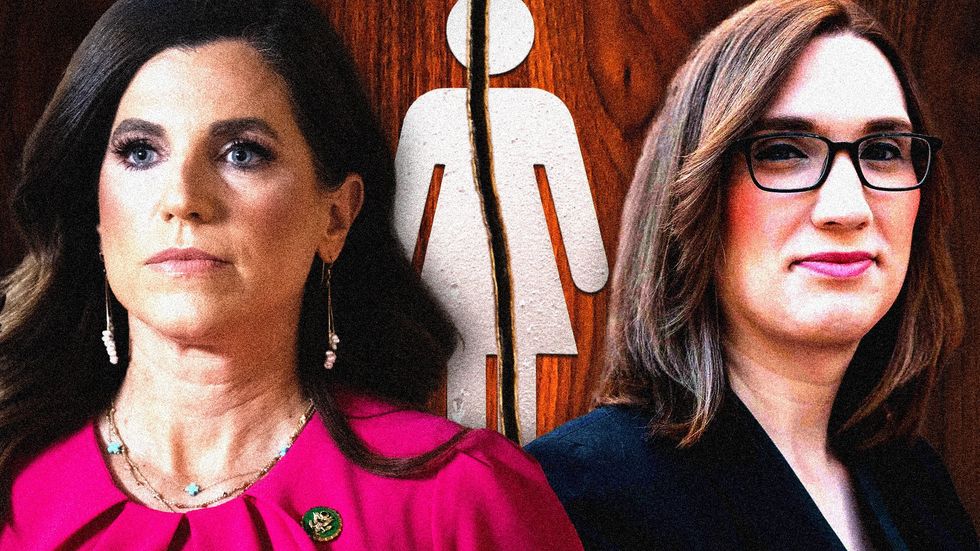Wednesday Western: 'The Ox-Bow Incident' (1943)
The murder of a sacrificial victim has always been justified as a healing, purifying, strengthening, fortune-producing, or empowering act. "The Ox-Bow Incident" is a movie about this mercy and violence. In the scene where the vigilantes gather under a hanging tree, they have a festive meal. Nooses dangle at the ready, but there’s no urgency, only shadow. Fueled up, the members of the posse tear off toward their victim. When the town judge hears about the posse, he gasps, 'That’s no posse; that’s a lawless lynching mob.' Then the lynch mob demands a sacrifice. Without even noticing, they get sucked into ritual, the presence of the sacred. Someone guides some horses beneath the dangling ropes. Right before the victims mount the saddles, the vigilantes announce two minutes of prayer. They remove their hats and bow their heads. The cinematography in these moments is frightening and beautiful. Otherworldly. Luminous. Gruesome. Deadly. "The Ox-Bow Incident" does not look, sound, or feel like a Western from the early 1940s. There’s a lot of silence, interrupted occasionally by a horn blast on the soundtrack. Other times, in heightened anxiety, the ugliest noises take over. There are lots of long shots where the camera barely moves. Lots of shadow. Lots of one-sided lighting. If you paused at the right moment and put a fancy frame around the TV, you’d have highbrow art on your wall. "The Ox-Bow Incident" could easily be a mid-1990s neo-noir Western. The only thing that kept it from winning Best Picture was a movie called "Casablanca." There’s an attention to symbols — literal attention. The movie directs your focus until you can’t look away. Something fishy Dialogue is natural yet poetic and constantly evolving. There are strange moments of comedy, like the man who goes by Major Tetley and wears a full Civil War uniform. Further humor arises when Gil Carter (Henry Fonda) and his buddy Art Croft comment on it. Gil Carter: “That renegade Tetley, strutting around in his uniform, pretending he's so much. He never even saw the South till after the war. Then only long enough to marry that kid's mother and get run out by her folks. Art Croft: “Figured there was something fishy about him, dressed like that.” Scandal and crisis Among the group of men is a large lady named Jenny “Ma" Grier with an Irish accent and a gruff demeanor. She fits in without ever trying. Some Westerns have bombshell pinups who shoot guns at outlaws. Others offer a woman whose motherhood is her refinement. In the case of "Ma" Grier, we have a wild lady with traits that seem masculine. Why else would she join a testosterone-fueled lynch mob? Then there’s Rose Mapen, the Venus figure. When she glances at the lynch mob, all the men raise their hats in salutation. This is her power. Don't forget that Venus caused the Trojan War. Mimetic violence Many Westerns offer a display of violence. "The Ox-Bow Incident," instead, looks at the causes of violence and how it comes to life. The film doesn’t show the founding murder, the act of violence that instigated the entire scapegoating cycle, but only the discord that caused it and the explosive and primitive response. This in-between is fascinating to me. It is a place of uncertainty, where people work together — or ought to. It’s the moment before a hangman yanks the lever, that pause when everyone is still alive, so the situation might take a sudden turn. When violence is involved, this whole bubbling mess becomes even more volatile. One dumb remark could ignite a crisis that can’t be undone. "The Ox-Bow Incident" finds its home in the strife between one tragedy and the next. So while the brutality is never directly shown, it is felt. And it becomes a noose to anyone who instigated the scapegoating. "The Ox-Bow Incident" captures every stage of this process. All against one At the start of the movie, the vigilantes have not formed a posse yet. One by one, the men gather outside the saloon to discuss the murder of a man they all knew. There is a slow escalation. At the start, all but one of them are practical. Then they begin to threaten one another in what seems to be a defensive maneuver. But nothing strengthens a lynch mob better than each person’s unspoken fear of becoming the victim. The ratio flips: The violent contagion spreads to all but one of them. Suddenly they are unanimous in their hunger to kill. This collective fever-mind transforms them into a single organism, ready to sacrifice the criminal. In these situations, the sacrifice is framed as a fulfillment of justice, with equal emphasis on compassion. Fueled up, the members of the posse tear off toward their victim. When the town judge hears about the posse, he gasps, “That’s no posse; that’s a lawless lynching mob.” In response, the deputy sheriff says he’ll deputize the men. The judge balks: That is illegal; it wouldn’t hold up. But the violent contagion spreads to the rest of town, and the l


The murder of a sacrificial victim has always been justified as a healing, purifying, strengthening, fortune-producing, or empowering act.
"The Ox-Bow Incident" is a movie about this mercy and violence. In the scene where the vigilantes gather under a hanging tree, they have a festive meal. Nooses dangle at the ready, but there’s no urgency, only shadow.
Fueled up, the members of the posse tear off toward their victim. When the town judge hears about the posse, he gasps, 'That’s no posse; that’s a lawless lynching mob.'
Then the lynch mob demands a sacrifice. Without even noticing, they get sucked into ritual, the presence of the sacred.
Someone guides some horses beneath the dangling ropes. Right before the victims mount the saddles, the vigilantes announce two minutes of prayer. They remove their hats and bow their heads.
The cinematography in these moments is frightening and beautiful. Otherworldly. Luminous. Gruesome. Deadly.
"The Ox-Bow Incident" does not look, sound, or feel like a Western from the early 1940s.
There’s a lot of silence, interrupted occasionally by a horn blast on the soundtrack. Other times, in heightened anxiety, the ugliest noises take over.
There are lots of long shots where the camera barely moves. Lots of shadow. Lots of one-sided lighting. If you paused at the right moment and put a fancy frame around the TV, you’d have highbrow art on your wall.
"The Ox-Bow Incident" could easily be a mid-1990s neo-noir Western. The only thing that kept it from winning Best Picture was a movie called "Casablanca."
There’s an attention to symbols — literal attention. The movie directs your focus until you can’t look away.
Something fishy
Dialogue is natural yet poetic and constantly evolving. There are strange moments of comedy, like the man who goes by Major Tetley and wears a full Civil War uniform. Further humor arises when Gil Carter (Henry Fonda) and his buddy Art Croft comment on it.
Gil Carter: “That renegade Tetley, strutting around in his uniform, pretending he's so much. He never even saw the South till after the war. Then only long enough to marry that kid's mother and get run out by her folks.
Art Croft: “Figured there was something fishy about him, dressed like that.”
Scandal and crisis
Among the group of men is a large lady named Jenny “Ma" Grier with an Irish accent and a gruff demeanor. She fits in without ever trying.
Some Westerns have bombshell pinups who shoot guns at outlaws. Others offer a woman whose motherhood is her refinement. In the case of "Ma" Grier, we have a wild lady with traits that seem masculine. Why else would she join a testosterone-fueled lynch mob?
Then there’s Rose Mapen, the Venus figure. When she glances at the lynch mob, all the men raise their hats in salutation. This is her power. Don't forget that Venus caused the Trojan War.
Mimetic violence
Many Westerns offer a display of violence. "The Ox-Bow Incident," instead, looks at the causes of violence and how it comes to life. The film doesn’t show the founding murder, the act of violence that instigated the entire scapegoating cycle, but only the discord that caused it and the explosive and primitive response.
This in-between is fascinating to me. It is a place of uncertainty, where people work together — or ought to. It’s the moment before a hangman yanks the lever, that pause when everyone is still alive, so the situation might take a sudden turn.
When violence is involved, this whole bubbling mess becomes even more volatile. One dumb remark could ignite a crisis that can’t be undone.
"The Ox-Bow Incident" finds its home in the strife between one tragedy and the next. So while the brutality is never directly shown, it is felt. And it becomes a noose to anyone who instigated the scapegoating.
"The Ox-Bow Incident" captures every stage of this process.
All against one
At the start of the movie, the vigilantes have not formed a posse yet. One by one, the men gather outside the saloon to discuss the murder of a man they all knew.
There is a slow escalation. At the start, all but one of them are practical. Then they begin to threaten one another in what seems to be a defensive maneuver. But nothing strengthens a lynch mob better than each person’s unspoken fear of becoming the victim.
The ratio flips: The violent contagion spreads to all but one of them. Suddenly they are unanimous in their hunger to kill.
This collective fever-mind transforms them into a single organism, ready to sacrifice the criminal. In these situations, the sacrifice is framed as a fulfillment of justice, with equal emphasis on compassion.
Fueled up, the members of the posse tear off toward their victim. When the town judge hears about the posse, he gasps, “That’s no posse; that’s a lawless lynching mob.”
In response, the deputy sheriff says he’ll deputize the men.
The judge balks: That is illegal; it wouldn’t hold up.
But the violent contagion spreads to the rest of town, and the lynch mob expands.
With a little coaxing from the judge and bartenders, the lynch mob dissipates, except for one of the men. But that’s all it takes: one person. He manages to revive the lynch mob.
Worse, the deputy sheriff follows through and deputizes the mob, so that the men can use their lawman status to make exceptions to the law.
The legal nature of this dilemma is no accident. Several times, the film offers commentary on the meaning and value of law. The tension of the movie arises from the barbaric expulsion of law. The fact that self-awarded sovereignty doesn’t work, that scapegoating doesn’t work, that semantics and force didn’t change the essence of the law are proof of the God-given nature of rights and freedoms.
But it’s difficult to stop a frenzy, because it usually reverts to majority rule and lynch mobs are full of people eager to enforce punishment — and eager to cede responsibility for their actions to the leader of the mob.
Sacrifice
In Shakespeare's "Julius Caesar," Brutus suggests murdering Caesar “for the good of Rome.” He alters the meaning of words to incite and persuade his fellow conspirators, whom he calls “gentle friends.”
He tells them: Guys, let’s be sacrificers, not butchers. “We aren’t going to kill Caesar; we’re going to ‘stand up against the spirit of Caesar / And in the spirit of men there is no blood.’ I mean, we’ll kill him boldly, but not wrathfully.”
Unfortunately, he tells them, this will require dismembering Caesar — but just literally, and that’s not what matters. Then the most disturbing line of his speech: “Let’s carve him as a dish fit for the gods / Not hew him as a carcass fit for hounds.”
This distinction is important. It offers two definitions for sacrificial murder. In the first, the victim is sanctified by his own death; he becomes sacred, acceptable to the gods. In the second, the victim is so far from sacred that he can’t even be considered human.
Neither one is correct. Both are murder. The scapegoater never wants the angry crowd to slow down enough to realize this. Anyone who tries to appeal to rationality and mercy becomes an outcast, making him a candidate for sacrifice.
Between these two extremes, we find humanity. It leads us back to the local, a gathering of people who choose law over violence. The tricky part is keeping a foothold on that middle ground.
"The Ox-Bow Incident" captures a view of this struggle, which each member of the lynch mob undergoes. It's a moral stress test. Everything is moving too fast for anyone to think clearly. It becomes a matter of instinct — and of hoping that your instincts won’t lead to tragedy, that you really are a good person.
Nobody wants to see his reflection in the tree with dangling nooses.
Originally Published at Daily Wire, World Net Daily, or The Blaze
What's Your Reaction?
































































































